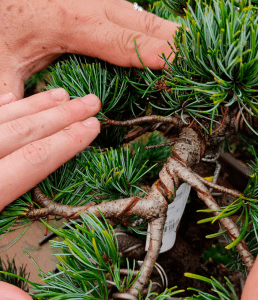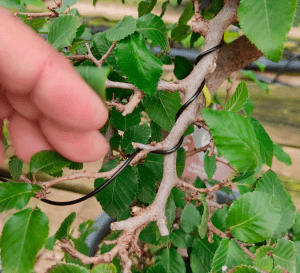How to wire and shape a bonsai

Wiring, in the bonsai world, is used to modify the position of the branches without having to prune them. In fact, wiring functions as big branches in large trees. With their weight they shape the branch’s system. If we compare it with the other techniques used for the cultivation of bonsai, the wiring is one of the most recent.
When do we have to wire our bonsai?
Generally, most bonsai species are wired in spring, although conifers may also be wired in autumn. We will leave the wire until we see that it begins to dig a little into the bark of the tree. We will always ensure that it does not get too deeply into the wood, leaving wounds and scars. The branches get thicker as the tree grows, so we will remove the wire before it “digs” into the bark.

This information is generalised. If you are thinking of wiring your bonsai, we recommend that you inform yourself specifically about the species you want to work with.
Types of wire
Copper wire for coniferous bonsai
Copper wire is used mainly for coniferous bonsai. It is a very malleable wire when working, but once in place it becomes rigid, losing all its movement. Why is this type of wire used in conifers and not in other bonsai species? Conifers have a fairly strong growth, so when they grow, the pressure on the wire is greater. Since it is very rigid, the wire remains firmly in place. Another reason to use it is because it camouflages with the trunk thanks to its colour.
Aluminium wire for bonsai in general
This type of wire is very malleable and does not lose its flexibility with time. It is used in most species of bonsai. They are made in different colours. For example, silver, black or copper. Although they differ in colour, they have the same function and qualities.
How do I choose the correct wire?
The first trick is that it should be 1/3 of the thickness of the branch that we want to wire. This trick loses credibility if we know that not all bonsai have the same flexibility in their branches and the same type of wood. With this in mind, we have prepared a blog for you where we explain an infallible trick to find the correct wire for your bonsai.
Tricks for wiring bonsai
Tools
If we use the right tools, we will perform this technique more comfortably. Here you can find all the necessary tools for wiring.
Strength
The wire is placed in the branches of the bonsai, exerting a little pressure. We must be careful with the force we make during this action. If we use little pressure, the wiring will be useless and will not fulfil its function. The thickness of the wire depends on the force to be made to bend the branches, in general the thicknesses range from 0.5 mm to 5 mm.
We must wind the wire little by little. It is convenient that there is a space between the wire and the branch. A little trick to bear in mind is that we should be able to pass a sheet of paper between the two of them. In any case, we must remember that if we exert too much force by screwing the wire around the branches, we will get nothing but negative results: we will leave ugly scars on the bonsai, or we could even break the branches.
The correct way to wire
In this section, we show you an example of the dos and don’ts when wiring a bonsai.
We have taken the example of a bonsai, in which we want a small branch to match better with the tree’s design. In the following image, we can see that the twig is very close to the main branch. Our goal is to make it more separate.
Next, you will see different incorrect ways of wiring and their solution:
- Wire too close together. This wiring position does not have any positive effect on the tree, since we cannot “mould the branch”. This way of wiring has no force and can restrict the flow of the sap, causing the branch to die.
- Not anchoring the wire well. If we do not anchor the wire well, it will not be able to make the adequate resistance to modify the shape of the branches. As you can see in this video, the wire moves because it does not have a good anchor.
- In this photo we can see the solution of these first two problems. First, we see that the wire is correctly anchored in the main branch so that it has enough force to reach the branch that we want to modify. We also see that the distance between turns is greater than in the example given above.
- Another incorrect way to wire our bonsai would be to trap the leaves between the wire and the branch. The leaves and shoots that remain below would be affected with malformations.
- The correct way will be to leave the leaves free. We will ensure that the new buds and shoots have room to grow well.
How to remove the wire
To remove the wire easily we need to cut it little by little, making a cut in each turn of the wire. The tips of the wire cutters must be perfectly aligned so that with each cut, a piece of wire is released.
Sometimes, if we wire with aluminium wire, we can carefully unwind the wire without cutting it piece by piece, but if the wire has become embedded it is better to cut it.
There are two types of wire cutters, a longer one, which is the most powerful, and a slightly shorter one. If you have small trees with thin branches, you should use a small wire cutter. If you are working medium or large trees, you will need a large wire cutter, which is capable of cutting even the thickest wires.
Have you already tried wiring your bonsai? We hope that with this article we have helped you learn a little more about this technique and encourage you to try it if you weren’t feeling brave enough.
Until next time!
About the Author
Mistral Bonsai
In Mistral Bonsai we are a communication team, technicians and masters committed from the first day to disseminating the wonderful art of bonsai. A world that offers many things to share. We believe that a bonsai is a tree with a soul, unique and unrepeatable. Another of our most essential pillars is, how could it be otherwise, our close commitment to the preservation of the environment and nature.
Categories
Bonsai cultivation and care (54)
Bonsai gift (2)
Bonsai pests and diseases (6)
Bonsai repotting (3)
bonsai substrates (2)
bonsai tools (1)
Bonsai work (10)
Ceramic pots (3)
Chinese culture (1)
Chinese culture (2)
Corporative Mistral Bonsai (8)
Cuidados del bonsái (22)
Cultivo del bonsái (20)
Dead wood (2)





